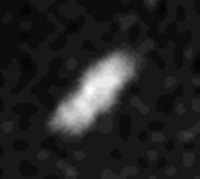Thalassa (moon)
 Naiad or Thalassa as seen by Voyager 2 (smearing has caused excessive elongation) | |
| Discovery | |
|---|---|
| Discovered by | Richard J. Terrile[1] and Voyager Imaging Team |
| Discovered in | September 1989 |
| Orbital characteristics[2] | |
| Semi-major axis | 50 075 ± 1 km |
| Eccentricity | 0.0002 ± 0.0002 |
| Orbital period | 0.31148444 ± 0.00000006 d |
| Inclination | 0.21 ± 0.02° (to Neptune equator) 0.21° (to local Laplace plane) |
| Is a satellite of | Neptune |
| Physical characteristics | |
| Dimensions | 108×100×52 km[3] |
| Mass | ~3.5×1017 kg (based on assumed density) |
| Mean density | ~1.2 g/cm3 (estimate) |
| Rotation period | assumed synchronous |
| Axial tilt | ~zero presumably |
| Albedo (geometric) | 0.09[3] |
| Surface temp. | ~51 K mean (estimate) |
| Atmosphere | none |

Thalassa (thə-las'-ə, IPA: [θəˈlæsə], Greek Θάλασσα), or Neptune IV, is the second innermost satellite of Neptune. Thalassa was named after a daughter of Aether and Hemera from Greek mythology. "Thalassa" is also the Greek word for "sea".
Thalassa was discovered sometime before mid-September, 1989 from the images taken by the Voyager 2 probe. It was given the temporary designation S/1989 N 5.[4] The discovery was announced (IAUC 4867) on September 29, 1989, but the text only talks of "25 frames taken over 11 days", giving a discovery date of sometime before September 18.
Thalassa is irregularly shaped and shows no sign of any geological modification. It is likely that it is a rubble pile re-accreted from fragments of Neptune's original satellites, which were smashed up by perturbations from Triton soon after that moon's capture into a very eccentric initial orbit.[5] Unusually for irregular bodies, it appears to be roughly disk-shaped.
Since the Thalassian orbit is below Neptune's synchronous orbit radius, it is slowly spiralling inward due to tidal decceleration and may eventually impact Neptune's atmosphere, or break up into a planetary ring upon passing its Roche limit due to tidal stretching. Relatively soon after, the spreading debris may impinge upon Despina's orbit.
References
- ^ Planet Neptune Data http://www.princeton.edu/~willman/planetary_systems/Sol/Neptune/
- ^ R.A. Jacobson and W.M. Owen Jr. (2004). "The orbits of the inner Neptunian satellites from Voyager, Earthbased, and Hubble Space Telescope observations". Astronomical Journal. 128: 1412.
- ^ a b E. Karkoschka (2003). "Sizes, shapes, and albedos of the inner satellites of Neptune". Icarus. 162: 400.
- ^ IAUC 4867 discovery IAUC circular
- ^ D. Banfield and N. Murray (1992). "A dynamical history of the inner neptunian satellites". Icarus. 99: 390.
